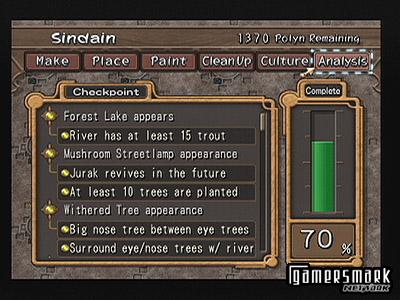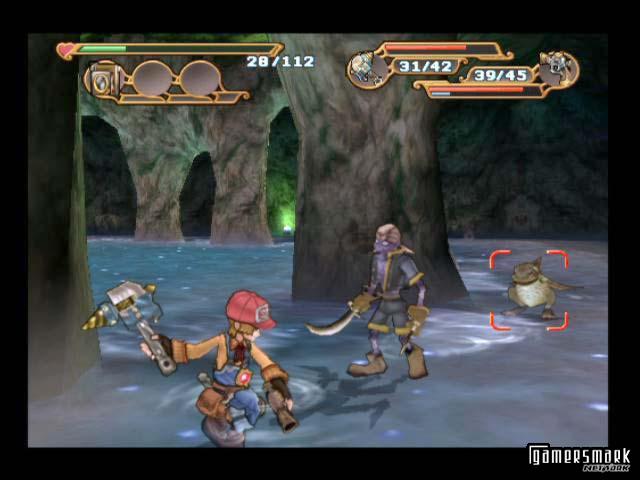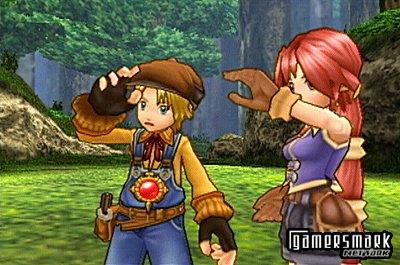Developer: Level 5 / Publisher: Sony Computer Entertainment || Overall: 9.3/10
The original Dark Cloud is known as one of the best adventure RPGs for the PlayStation 2. Thus, players clamored for a sequel, and with listening ears Sony has brought us Dark Cloud 2. If you’re a Dark Cloud fan, you will be thoroughly impressed with the effort by Sony to make this sequel truly all that it should be and more. Everything in Dark Cloud (including the translation) has been greatly improved.
Dark Cloud 2 is about a young boy, named Maximillian (or Max for short), and a young princess from the future, Monica. The story starts when Monica goes to the past from the future to stop an evil guy, only known as Griffin, from destroying the past, therefore destroying the future. Don’t ask why this makes sense, because if Griffin was going to destroy the past, how would the future be able to know he was going to if they were destroyed? Just take it for what it is, and you’ll have a fun time playing this game.
The Georama system that made the first Dark Cloud so original, (which is the aspect of the game in which you can build your own towns for people to live in) has been revamped and loaded with new features that make your towns more customizable. Not only did the Georama system get a major improvement, but the battle system, storyline, interactivity, and user interface had all been greatly improved. Dark Cloud 2 is everything Dark Cloud was, should have been, and so much more.
The similarities between Dark Cloud and Dark Cloud 2 are the same as the similarities between any of the Final Fantasy games. All that is in common between the two Dark Cloud games is the concept of using Georama to rebuild the world, and go through a merciless amount of dungeons to do so. And let me tell you right now, the best part of the game is going through the dungeons (and that’s a good thing).
Somewhat of a new aspect to the game is the ability to freely travel to and fro from the future to the past.
Graphics:
The only improvement that some may see as a turn-away from this game is that instead of the generic computer-graphic-look, the game is cel-shaded. Let me say this again, the game is cel-shaded. Even though some may see this as a bad thing, I see it as a good thing. The game looks amazing, and I believe that the cel-shading makes the game what it is.
Compared to games using the conventional computer-graphic look, every aspect of this game, visually, is amazing. The cel-shading mixed with a right amount of regular computer graphics make for a very pleasant experience. Just because it may look cartoony, doesn’t mean it doesn’t look good.
Sound:
The sound in this game is great. Every part of the game has good music. After 90+ hours of playing this game, I still have not gotten sick of any of the songs. The music makes you feel like you’re in the area you’re in, whether it be a volcano, a tower, or the future.
When the story is advancing, there is voice acting. However, the voice acting makes the game seem more kid-like, because there are a few weird voices that seem to have been made to entertain younger children, even if the game is not really made for them.
Game Play:
There are two main aspects of the game. There is the battle system and the town interaction/Georama system, as well as a few extras tossed into the gaming mix.
The battle system has improved so much since the last Dark Cloud, that it makes it easier for you to be efficient with your battle tactics. Instead of having six playable characters with different abilities (as in the first one), you have only two characters, whom each have two weapons (close and long ranged weapons) at their disposal in addition to an “alternative” mode of fighting. Max is equipped with huge wrench-like weapons (because he’s an inventor), and a gun. Max also has a huge robot named Steve. You may remember “Steve” as the talking slingshot from Dark Cloud. Well, now he’s a powerful robot that can be fairly annoying if you choose to equip him with a voice box. Steve is almost a character by himself, as he has his own hit points, weapons, and uses. Steve becomes especially useful farther along in the game, when the enemies become extremely hard. Monica is equipped with the conventional sword, and a bracelet that can shoot magic. That’s not the interesting part about her though. She’s able to transform into particular enemies you encounter throughout the game. This is fairly useful, as each of the different monsters have skills that are needed to complete tasks in the game.
The main part of the game is the dungeon-exploring. Going through dungeon after dungeon was the whole purpose of Dark Cloud, and the same goes for Dark Cloud 2. The main point is that you go to a part of a dungeon, find the key to go to the next level, and go to the next part of the dungeon. As you venture through the seemingly endless amount of dungeons, you improve your characters mainly by improving the weapons they carry. You do this by “synthesizing” or basically adding a particular item’s ability-gaining-potential to the weapon.
Synthesizing has been tweaked a bit from the first Dark Cloud. At every “level” the weapon gains from use (and depending on how advanced the weapon is), it will gain a certain amount of “synthesize points” instead of just putting a bunch of different things in slots and having them join with the weapon. The battle system is very deep, and to explain it here would take too long.
The other part of the game that you’ll be spending time with is the town interaction/Georama system. Town interaction plays a big part in the beginning, but declines as you make the towns through the Georama system. The first town, which is made by the developer, is obviously more grandiose and interesting than any of the ones you make. An interesting part of town interaction is the camera. The camera is used to document certain types of items, which is used for other purposes. However, this provides for some pretty fun photo shoots. When you first get the camera, you’ll be taking pictures of everything you see, trying to get every single item (which there are a few hundred of).
Like I said before, the Georama system had been greatly improved, and makes for some very nice customization of the towns you have to rebuild. Instead of having the actual items being provided for you to right away place on the map, you must actually CREATE them with the building materials you acquire. This makes for a less far-fetched reason for being able to make a town by yourself, out of nothing. In Dark Cloud you didn’t have to meet the conditions of the original town, except to get prizes for doing so. In Dark Cloud 2, however, you have to do 100% of what the town is supposed to have in it. An example would be “Place trees around the Elven house.” This would complete a certain condition you had to do to restore the future, because in the future’s past, the Elven house had trees around it. Also, you must have a certain amount of “culture points” which almost forces you decorate the town with certain things, to make it seem like a more believable town.
Some extra aspects to the game are the invention system, Spheda, and fish raising/racing.
The invention system comes in play when you take pictures of certain items. These pictures supply Max with ideas to be able to make a certain invention, for instance a bomb or a weapon. The way it works, is if you put three ideas together, you may or may not be able to create a “complete” idea that will allow you to create a particular object.
Spheda in this game is basically an advanced form of golf. The explanation behind Spheda is that there are space/time distortion thing, in which a blue or red sphere falls out of a blue or red distortion. The goal of Spheda is simply to put the sphere of glowing space/time back into the portal. You may ask now “why don’t the just pick it up and put it back in.” You idiot! Don’t you know if you pick up a piece of space/time you’re going to possibly change the future (as if hitting it with a golf club makes it any better…)!?! Anyhow, to win at a particular game of Spheda, you must defeat all the enemies in a dungeon, after which, the distortion and the sphere will appear at random places on the map. The dungeons are all randomly generated, so it makes for some very frustrating times. Basically, you have to get the sphere an opposite color of the distortion to make it go in (Red sphere -> blue distortion, blue sphere -> red distortion). This adds for some difficulty, as you may be able to hit the sphere into the distortion, but it doesn’t go in because it is the same color as the distortion (which is bad). Have fun with this one. Even though it isn’t a required part of the game, its still very useful getting the item out of the treasure box that falls out of the distortion after it is repaired.
Fishing. Fish raising. Fish racing. This all seems kind of boring, and let me tell you it pretty much is. But if you play your cards right, you’ll be able to get some very good items and weapons. I think its sort of self-explanatory as to what you do with the fish.
Overall:
Well, after all that we’ve been through with each other, I’m afraid it won’t even come close to how long you will play this game. I haven’t said one bad thing about this game, but there is a factor of the game becoming rather boring at times, as well as getting an “oh yay you finished an area, now go to the next one and do the same thing you did before” feeling about midway through the game. Nothing really happens during the middle part of the game, as it is really just gets you prepared for the unloading of the story, and mess of difficult enemies and bosses near the end of the game.
There are about seven different areas, all corresponding with a particular element. Such as, fire, water, wind, earth, air, and a couple of extra areas. The reason it becomes so boring, is that when you go through the dungeons, there usually isn’t any story sequences at each part. The only reason they become boring is if you’re trying to play all the way through a bunch of the dungeons at the same time. If you give it a little break in between every few dungeons, it’d be less of a bore. But to break up the monotony of the dungeons, the developers have tossed in many, many extra mini games and side quests to have fun with.



